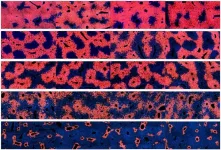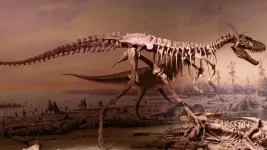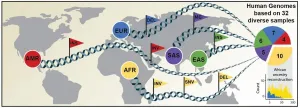Farmers in developing countries can protect both profits and endangered species
2021-02-25
(Press-News.org) HOUSTON - (Feb. 25, 2021) - Low-income livestock farmers in developing countries are often faced with a difficult dilemma: protect their animals from endangered predators, or spare the threatened species at the expense of their livestock and livelihood.
A new paper by Rice University economist Ted Loch-Temzelides examines such circumstances faced by farmers in Pakistan. "Conservation, risk aversion, and livestock insurance: The case of the snow leopard" outlines a plan under which farmers can protect themselves from crippling financial losses while preserving and possibly benefiting from the lives of endangered predators.
"These livestock owners often have very low incomes," Loch-Temzelides said. "The loss of even one animal can be financially devastating. They're faced with the difficult task of weighing conservation efforts against economic losses due to attacks on their herds. And this situation isn't limited to snow leopards -- it applies anywhere large predators live near livestock."
Loch-Temzelides proposes establishing community livestock insurance contracts for farmers in developing countries who don't have access to the types of policies available in more developed nations. Under these contracts, farmers would agree to share the cost of lost animals with other farmers in their community. For example: If one farmer in a community of 10 lost an animal valued at $100, each community member would lose the equivalent of about $10.
By aiding conservation efforts, he added, farmers may stand to reap additional benefits.
"Tourists around the world are willing to pay to see endangered species such as snow leopards in their natural habitats," Loch-Temzelides said. "And revenue from ecotourism can benefit communities and their residents significantly."
While Loch-Temzelides' study focuses on Pakistan, he hopes community livestock insurance can be useful around the world.
INFORMATION:
The study will appear in an upcoming edition of the journal Conservation Letters and is available online at
https://conbio.onlinelibrary.wiley.com/doi/10.1111/conl.12793.
This news release can be found online at news.rice.edu.
Follow Rice News and Media Relations on Twitter @RiceUNews.
Photo link: https://news-network.rice.edu/news/files/2021/02/115314887_l.jpg
Photo credit: 123rf.com
Located on a 300-acre forested campus in Houston, Rice University is consistently ranked among the nation's top 20 universities by U.S. News & World Report. Rice has highly respected schools of Architecture, Business, Continuing Studies, Engineering, Humanities, Music, Natural Sciences and Social Sciences and is home to the Baker Institute for Public Policy. With 3,978 undergraduates and 3,192 graduate students, Rice's undergraduate student-to-faculty ratio is just under 6-to-1. Its residential college system builds close-knit communities and lifelong friendships, just one reason why Rice is ranked No. 1 for lots of race/class interaction and No. 1 for quality of life by the Princeton Review. Rice is also rated as a best value among private universities by Kiplinger's Personal Finance.
ELSE PRESS RELEASES FROM THIS DATE:
2021-02-25
While the amazing regenerative power of the liver has been known since ancient times, the cells responsible for maintaining and replenishing the liver have remained a mystery. Now, research from the Children's Medical Center Research Institute at UT Southwestern (CRI) has identified the cells responsible for liver maintenance and regeneration while also pinpointing where they reside in the liver.
These findings, reported today in Science, could help scientists answer important questions about liver maintenance, liver damage (such as from fatty liver or alcoholic liver disease), and liver cancer.
The liver performs vital functions, including chemical detoxification, blood protein production, bile excretion, and regulation of energy metabolism. Structurally, the liver ...
2021-02-25
Paleo-ecologists from The University of New Mexico and at the University of Nebraska-Lincoln have demonstrated that the offspring of enormous carnivorous dinosaurs, such as Tyrannosaurus rex may have fundamentally re-shaped their communities by out-competing smaller rival species.
The study, released this week in the journal Science, is the first to examine community-scale dinosaur diversity while treating juveniles as their own ecological entity.
"Dinosaur communities were like shopping malls on a Saturday afternoon ? jam-packed with teenagers" explained Kat Schroeder, a graduate student in the UNM Department of Biology who led the study. "They made up a significant portion of the individuals in a species and would have had a very real impact ...
2021-02-25
An international team of scientists has developed a system that can generate random numbers over a hundred times faster than current technologies, paving the way towards faster, cheaper, and more secure data encryption in today's digitally connected world.
The random generator system was jointly developed by researchers from Nanyang Technological University, Singapore (NTU Singapore), Yale University, and Trinity College Dublin, and made in NTU.
Random numbers are used for a variety of purposes, such as generating data encryption keys and one-time ...
2021-02-25
As Covid-19 impacts lives around the world- a new skeleton study is reconstructing ancient pandemics to assess human's evolutionary ability to fight off leprosy, tuberculosis and treponematoses with help from declining rates of transmission when the germs became widespread.
The researchers state the germs mutated to infect ancient humans so they could replicate- hopping across to as many new hosts as possible- but the severity of the diseases reduced as a result.
The analysis by Adjunct Professor in Archaeology Maciej Henneberg and Dr Teghan Lucas at Flinders ...
2021-02-25
In 2001, the International Human Genome Sequencing Consortium announced the first draft of the human genome reference sequence. The Human Genome Project, as it was called, had taken more than eleven years of work and involved more than 1000 scientists from 40 countries. This reference, however, did not represent a single individual but instead is a composite of humans that could not accurately capture the complexity of human genetic variation.
Building on this, scientists have carried out many sequencing projects over the last 20 years to identify and catalog genetic differences between an individual and the reference genome. Those differences usually ...
2021-02-25
A chemical reaction can be understood in detail at the quantum state-resolved level, through a combined study of molecular crossed beam experiments and theoretical quantum molecular reaction dynamics simulations.
At a single collision condition, the molecular crossed beam apparatus is able to detect the scattering angle-resolved product with rotational state-resolution. Whereas, with accurate global potential energy surface, quantum reactive scattering theory is able to predict the corresponding reactive scattering information.
In previous studies, the chemical reaction dynamics was revealed only with the product rotational state-resolution. And the investigation of a reaction ...
2021-02-25
Although the value of vaccines for COVID-19 may seem obvious, government action and investment in vaccines have not been commensurate with the enormous scale of benefits they offer, argue Juan Camilo Castillo and colleagues in this Policy Forum. Since even one extra month of exposure to COVID-19 kills hundreds of thousands, reduces global gross domestic product (GDP) by hundreds of billions of dollars, and generates large losses to human capital by harming education and health, expanding vaccine capacity even further would generate substantial global benefits. Castillo et al. report results of two related exercises: estimating the global benefits from vaccine capacity already in place, and estimating the benefits ...
2021-02-25
The pandemic has made clear the threat that some viruses pose to people. But viruses can also infect life-sustaining bacteria and a Johns Hopkins University-led team has developed a test to determine if bacteria are sick, similar to the one used to test humans for COVID-19.
"If there was a COVID-like pandemic occurring in important bacterial populations it would be difficult to tell, because before this study, we lacked the affordable and accurate tools necessary to study viral infections in uncultured bacterial populations," said study corresponding author Sarah ...
2021-02-25
Bladder cancer is more aggressive and more advanced in South Texas residents than in many parts of the country, a study by the Mays Cancer Center, home to UT Health San Antonio MD Anderson, indicates.
The disease is also deadlier in Latinos and women, regardless of where they live nationwide, according to the research.
The team from The University of Texas Health Science Center at San Antonio (UT Health San Antonio), which includes the Mays Cancer Center, compared bladder cancer cases in the Texas Cancer Registry with cases in the Surveillance, Epidemiology and End Results (SEER) Program. SEER, which collects data on cancer cases from various locations and sources across the U.S., does not include Texas statistics.
Cases covered the years ...
2021-02-25
A Skoltech researcher has developed a theoretical model of wave formation in straits and channels that accounts for nonlinear effects in the presence of a coastline. This research can improve wave prediction, making maritime travel safer and protecting coastline infrastructure. The paper was published in the journal Ocean Dynamics.
Predicting surface weather at sea has always been a challenging task with very high stakes; for instance, over 4,000 people died due to rough seas during Operation Overlord at Normandy in June 1944, an allied incursion where poor forecasting altered the course of the operation quite significantly. Current wave forecasting models used, for example, by NOAA in the US, are imperfect, but they have many tunable parameters to ensure a reasonably good prediction.
However, ...
LAST 30 PRESS RELEASES:
[Press-News.org] Farmers in developing countries can protect both profits and endangered species





